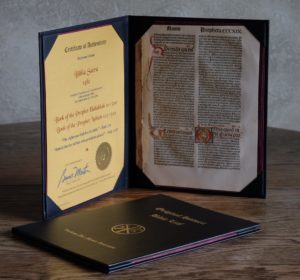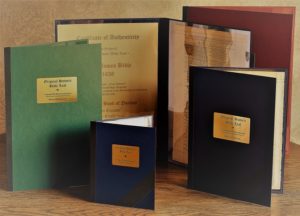Hello! My name is Bruce Martin. I started Historic Bibles, LLC in 2005 when collecting Bible leaves by non-specialists was nascent. As a specialist in theology (Th.D.; see below), I was amazed at what was available, especially the manuscripts. The preservation of these ancient or “historic” Bible leaves and manuscripts was the obvious counter-part. But nightmare situation for me was that, without proper care, these precious leaves and manuscripts would simply be thrown out with the trash when the original owner died. What was lacking, I thought, was a way to preserve the leaves from future destruction. To that end, I — assisted by my equally dedicated wife Martha, developed a way (apart from expensive framing) to preserve and artfully display Bible leaves and manuscripts that would ensure their preservation. No one, surely, would dispose of a Bible leaf if it was set in one of my Portfolios or Booklets! We still believe that today.
The leaves we offer — mostly PREMIUM leaves of high theological impact — are set in either a museum-quality Portfolio or an Archival Booklet. Some items, notably our Engravings, are either framed and matted exactly as in the finest museums or set in landscape Portfolios. All materials we use conform to the highest standards for archival preservation as advocated by the Library of Congress.
In addition, I have made a special effort to translate important verses into English from the original Latin or Hebrew or Greek, so that the owner of a leaf or manuscript can “read” what is written. One can now purchase an original Latin or Greek leaf with some indication of what that leaf says, and compare it to the Bible one has at home. Since nearly all of the Bible leaves and manuscripts produced prior to 1535 were in Latin, these same leaves are now available to English readers with partial translations.
Our Portfolios and Booklets



Portfolios are classically designed with black linen cloth covers, burgundy silk moire linings, and crystal clear archival sleeves to protect the leaves and manuscripts “for a thousand years” against the outer elements, ink oxidation and rag/paper decomposition. Archival Booklets are hand made of heavy linen-fiber stock, and contain two archival sleeves (same as in the Portfolios) for complete protection of the leaf and COA. Our aim is a tasteful, artistic, and archival presentation of the leaf, manuscript, or engraving.
Most medium-sized, premium leaves and manuscripts are set in Bifold Portfolios. Since most Bibles were of this size (about 8″ – 10″ tall), most of our Bible leaves will be found here. Bifold Portfolios come in two sizes, for leaves and manuscripts up to 11″ tall, and for leaves and manuscripts up to 13″ tall. Both are found under Bifold Portfolios.
Smaller leaves and smaller manuscripts are set in Trifold Portfolios. Most manuscripts and early Latin Bibles are in this smaller size (about 6″ – 7″ tall), though many early Greek printings are of this size also. Trifold Portfolios contain (1) the leaf or manuscript, (2) the COA on premium “gold-leaf” paper with gold seal and signature, and (3) a short “History of the Latin/Greek Bible” along with an English translation of some important verses.
Larger Bible leaves (over 13″ tall) or smaller semi-premium leaves (less than 13″ tall) are set in Archival Booklets. Some leaves, often including non-premium leaves, may also be set in Archival Booklets in order to keep the prices reasonable. Engravings or engraving sets are set in either Bifold Portfolios (for engravings up to 14″ x 11″) or museum-quality archival frames.
By the Finger of God
About 3,000 years ago, the Creator of the universe spoke to us through words written “by the finger of God” (Deut. 9:10). Prior to printing, the Bible was written by hand, on papyrus or parchment, often taking years to produce a single copy. Despite the cost, Bibles were as artistic as they were exacting, and many stunning illuminated texts survive. With the advent of printing c.1454, the Bible became available to the laity and hastened the Reformation and the Renaissance. To preserve for posterity a rare leaf or manuscript from an historic Bible is thus to be connected to the ongoing creativity of God’s word.
From early on, Christians held on to “fragments” of older copies of the Bible, until those fragments were either burned or dissolved into dust; yet still, many early fragments survive to this day in museums or in private collections. Jews, on the other hand, meticulously copied from worn-out copies and then respectfully disposed of the older copies. Either way, the preservation and presentation of historic Bible leaves and manuscripts is one link in that great chain of witnesses to the God of Abraham, Isaac and Jacob.
The motto on each Portfolio reads: Verbum Dei Manet Aeternum (“The Word of God Remains Forever”), from Isaiah 40:8 and 1 Peter 1:25. My wife and I started Historic Bibles on this solid foundation, as a way of bringing the historically bound written Word into homes and offices. God uses created things, such as the spoken word and Bible fragments, in order to be heard: “He who has ears to hear, let him hear!” (Mark 4:9 par.)
Credentials
B.A., Religious Studies, Temple University, 1975
M.Div., Lutheran Theological Seminary, 1980. Pastor, 1980-1985.
Th.D., Th.M., Lutheran School of Theology, 1992, 1985. Systematic Theology. Dissertation on Interreligious Dialogue.




